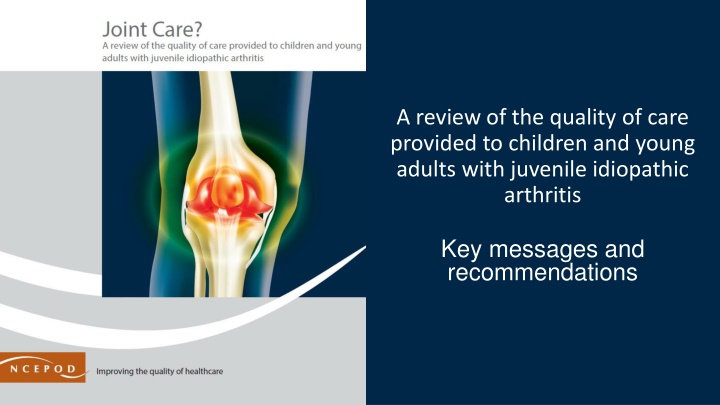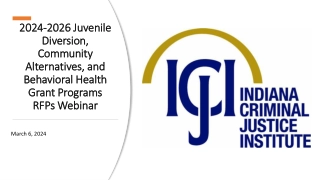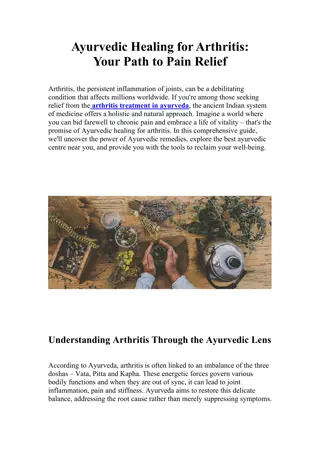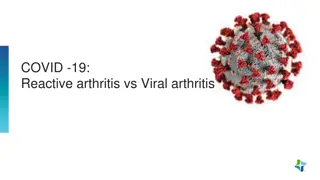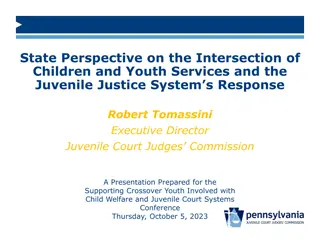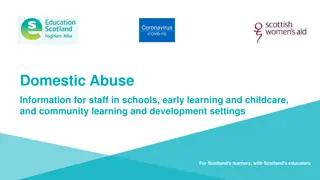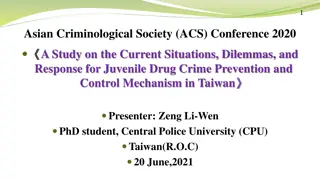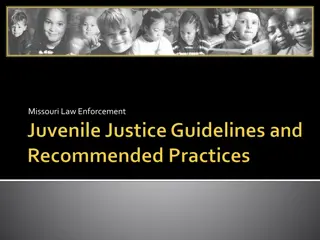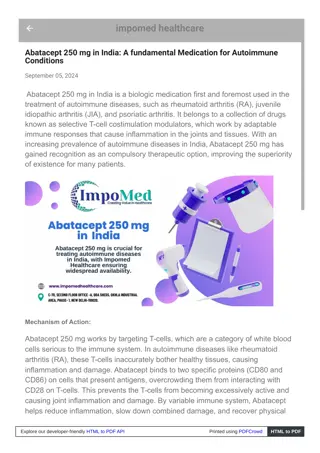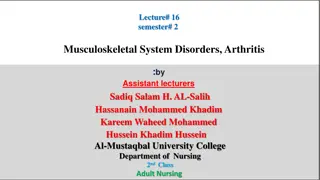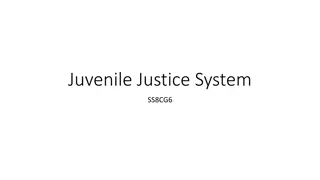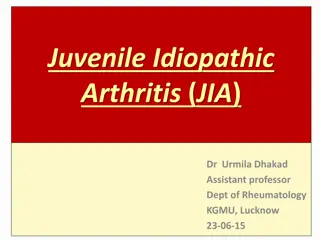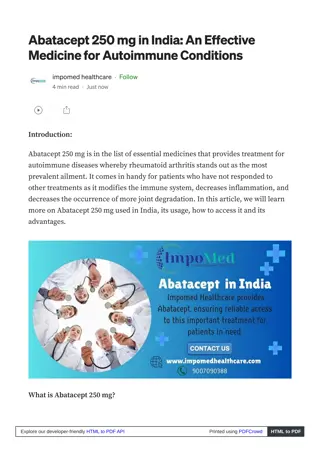Review of Care for Children & Young Adults with Juvenile Idiopathic Arthritis
Key messages & recommendations from a study on care quality provided to individuals with JIA. Findings highlight areas for improvement in awareness, referral pathways, and patient training.
Download Presentation

Please find below an Image/Link to download the presentation.
The content on the website is provided AS IS for your information and personal use only. It may not be sold, licensed, or shared on other websites without obtaining consent from the author.If you encounter any issues during the download, it is possible that the publisher has removed the file from their server.
You are allowed to download the files provided on this website for personal or commercial use, subject to the condition that they are used lawfully. All files are the property of their respective owners.
The content on the website is provided AS IS for your information and personal use only. It may not be sold, licensed, or shared on other websites without obtaining consent from the author.
E N D
Presentation Transcript
A review of the quality of care provided to children and young adults with juvenile idiopathic arthritis Key messages and recommendations
The Study Study population: Children and young people aged 0-24 years, with a diagnosis of JIA, who were being seen by the rheumatology department as an outpatient or who presented to hospital between 1st April 2021 and 31st March 2023. Data sources: Clinician questionnaire Combined GP clinician and organisational questionnaire Case reviews Organisational questionnaire Patient and parent carer survey Clinician survey
1 Raise awareness of JIA and its symptoms with those who might see patients Better recognition would encourage faster referral to rheumatology which may prevent joint damage. 23/101 (22.8%) GP practices reported having protocols for the investigation and care of patients with suspected JIA. 20/54 (37.0%) parents/carers felt that they were not taken seriously by the GP during the consultation.
Streamline your local referral pathway, with clear timelines for patients with suspected JIA 2 Pathways exist but vary between hospitals. It is not always clear who is involved, leading to incorrect referrals. The most common reason for delay in being seen by a rheumatologist was initial referral to the wrong speciality. 71/266 (26.7%) patients had a delay in assessment by a rheumatologist. Only 12/58 (20.7%) patients were referred directly to a rheumatologist.
Provide prompt training to patients/parents/carers on how to inject medications for JIA 3 Patients/parents/carers do not always get trained to administer methotrexate, which can lead to a delay to treatment starting. 22/118 (18.6%) patients and parents/carers had no evidence of being trained in how to give methotrexate injections. 26/298 (8.7%) patients had inappropriate medications given while patients and parents/carers waited for training on how to give injections.
Ensure ongoing access to physiotherapy, occupational therapy, pain and psychology services 4 Many patients have JIA as adults and so equivalent access to care needs to exist from diagnosis through to adulthood. 193/290 (66.6%) patients saw a physiotherapist - 54 not seen should have. 62/290 (21.4%) patients saw an occupational therapist - 67 not seen should have. There was a trend towards less involvement of physiotherapy, occupational therapy and psychology from paediatrics into adulthood.
Provide a holistic, developmentally appropriate rheumatology service for patients with JIA 5 Being diagnosed with JIA at a young age, impacts all aspects of wellbeing and education, which is not always addressed. Only 48/101 (47.5%) adolescent clinics were in an age-appropriate environment. Being seen out of school hours was reported for 2/114 (1.8%) patients. Only 114/262 (43.5%) patients had their holistic health supported. Signposting to peer support decreased with age.
Raise awareness of JIA Raise awareness of juvenile idiopathic arthritis and its symptoms with the healthcare professionals who will see this group of patients. Symptoms include: Painful, swollen or stiff joint(s) A fever that keeps returning Joint(s) that are warm to touch A limp but no injury Increased tiredness Target audiences: Royal College of General Practitioners, Royal College of Paediatrics and Child Health, Royal College of Physicians, British Society for Children's Orthopaedic Surgery, British Orthopaedic Association, Royal College of Ophthalmologists and Royal College of Emergency Medicine, Getting it Right First Time Supported by: Musculoskeletal leads with a responsibility for children and young people working with integrated care boards, commissioners, executive boards, NHS England, Welsh Government, Department of Health Northern Ireland, Government of Jersey
Streamline and publicise pathways Streamline and publicise local referral pathways with clear measurable timelines for patients with suspected juvenile idiopathic arthritis. Ensure that this includes: The ability to refer patients with suspected JIA directly from primary care to a secondary/tertiary care rheumatology service where a diagnosis can be made and ongoing care provided Access to advice from rheumatology services regarding the need for/appropriateness of investigations at the time of referral Agreed referral pathways within secondary care from specialties such as orthopaedics and emergency medicine to age-appropriate rheumatology services Agreed referral pathways from rheumatology services to ophthalmology clinics (including same day/ combined clinics) with clear standards for referral and follow-up timeframes Direct access to age-appropriate services if the patient should have a disease flare or other urgent disease- related issue. Target audience: Medical directors and healthcare professionals treating patients with JIA Supported by: Integrated care boards, commissioners, executive boards, Getting it Right First Time
Access to the MDT Provide timely access to appropriately trained physiotherapy, occupational therapy, pain and psychology services at the diagnosis of juvenile idiopathic arthritis, and then as needed through adolescence and adulthood. Target audience: Medical directors and healthcare professionals treating patients with JIA Supported by: Integrated care boards, commissioners, executive boards, Getting it Right First Time
Age-appropriate information Offer age-appropriate information about juvenile idiopathic arthritis and medication risks and benefits to patients and their parents/carers at diagnosis and on an ongoing basis. Target audience: Healthcare professionals treating patients with JIA
Age-appropriate information Provide training to the patient, if age-appropriate, and/or their parents/carers on how to administer subcutaneous injections for juvenile idiopathic arthritis at the point treatment is initiated. Target audience: Healthcare professionals responsible for training on administration of medications for JIA Supported by: Integrated care boards, commissioners, executive boards, Getting it Right First Time
Timely access to intra-articular steroid injections Ensure timely access to intra-articular steroid injections by staff who have been trained to deliver age-appropriate care in units where local or general anaesthesia can be delivered. Target audience: Integrated care boards, commissioners, medical directors and healthcare professionals treating patients with JIA Supported by: Orthopaedic surgeons, anaesthetists, theatre booking staff
Holistic, developmentally appropriate care Provide a holistic, developmentally appropriate rheumatology service for patients with juvenile idiopathic arthritis. Target audience: Medical directors and healthcare professionals treating patients with JIA Supported by: Integrated care boards, commissioners, executive boards, Getting it Right First Time
NICE guidelines Develop NICE guidance for the management of juvenile idiopathic arthritis. Target audience: National Institute for Health and Care Excellence
REPORT and TOOLS http://www.ncepod.org.uk/2025jia.html Report Summary Infographic Recommendation checklist Audit tool Driver diagram Fishbone diagram Commissioners guide
